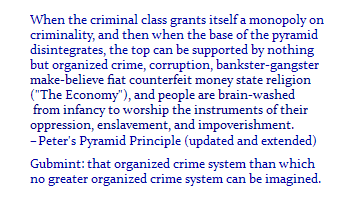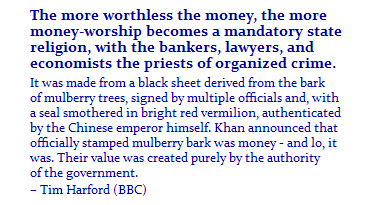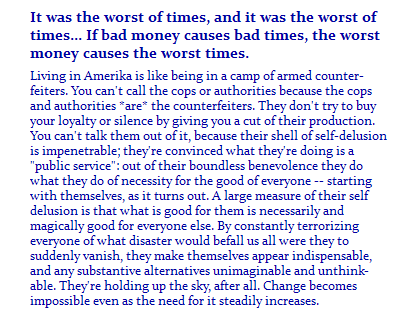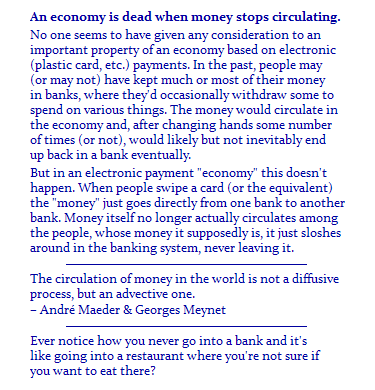
Lenin was certainly right. There is no subtler, no surer
means of overturning the existing basis of society than to
debauch the currency. The process engages all the hidden
forces of economic law on the side of destruction, and
does it in a manner which not one man in a million is
able to diagnose.
- John Maynard Keynes (1920)
According to Gresham's Law -- said by Sykes (1992, pg 19) to be
"named (erroneously) after the Elizabethan financier Sir Thomas

When I was a kid they took the last trace of silver out of (US) dimes. I remember people immediately started checking their change at the cash register for the silver ones, and took the quickly dwindling number out of circulation in a jiffy, feeling lucky if they got one. These became collectibles, stashed away somewhere and taken out of circulation.
That's Gresham's Law in action: people hoard the better money and try to get rid of the debased money which has been dumped into the system to replace it.
How do they do this? By spending it!
This is a way of getting rid of it while still getting something
for it, rather than just tossing it in the trash. Pass it along to the
 next chump while you still can, before reality sets it and it achieves
it's true value.
next chump while you still can, before reality sets it and it achieves
it's true value.
The bad money then goes into circulation and the good money goes out of circulation. Bad money believers and proponents are constantly trying to use the fact that bad money circulates so well, i.e., its utility, as proof of its inherent goodness, that the people like it just fine, but this is a transparent tautology.
The argument for BitCoin, like the sales pitch one hears so frequently from the gold bugs for gold, is that it is better money in some respects than the money currently in circulation. Therefore it will never replace fiat paper currency. It won't drive it out of circulation. It was never intended to. (Read the original white paper.) There is no Inverse Gresham's Law. BitCoin was never intended to replace bad money by being better money. This mythology (and others) about BitCoin has been invented and perpetrated by the bad money crowd, who are constantly in terror that their money counterfeiting racket will be uncovered and done away with, that people will suddenly snap out of their mass hypnosis, that their worthless money grown on trees and printed out of thin air will suddenly turn into what it already is (nothing), that the emperor will be discovered to not be wearing any clothes.
All these pieces of paper are issued with as much solemnity and authority as if they were of pure gold or silver... and indeed everybody takes them readily, for wheresoever a person may go throughout the Great Kaan's dominions he shall find these pieces of paper current, and shall be able to transact all sales and purchases of goods by means of them just as well as if they were coins of pure gold.
— Marco Polo, The Travels of Marco Polo (13th century)
Needless to say we're not using these anymore. When they eventually reach their true value (nothing) and expire worthless, whoever is holding them gets stuck with the (empty) bag. It is the solemnity that is the tip-off there's bamboozling going on.

Just as for gold, the cost to mine BitCoin can be calculated. Even from afar, at least roughly. According to efficient market theory the exchange rate should trend toward that value, plus a small margin for profit.
If BitCoin trades at a premium then this will attract more miners. The rate of production, being fixed, won't increase, so the added competition will simply distribute the number of new BitCoin among more miners, until the profit margin starts to evaporate and the rationale for mining drives the highest cost producers out of biz.
What is this amount?
I only have one datapoint for the economics of mining. It came from a short TV piece (on CBS?) a few months ago (early 2018), and while I have no real reason to doubt the veracity of what the miner said, one never knows if the numbers were shaded one way or the other for whatever reason.

He had a small warehouse in eastern Washington, so he draws on relatively inexpensive Columbia River hydro-electric dam power. It didn't say what rate he was paying for this, or whether he got some sort of industrial/volume discount for being a big customer, only that his monthly electricity bill was $100,000, or some $3300 per day.
Beyond that, the only other number mentioned was that he mines 5-6 BitCoin per day.
This works out to a bare bones (marginal) cost of about $600 per BitCoin. Everyone agrees it's the electrical power which is the main cost in mining, so if we split it 60/40 with everything else that goes into the cost of production (the building, the mining machines, etc.), the latter totals about $400, and we end up with a net cost of around $1000 per BitCoin as a very ballpark-ish figure for the cost of mining/production. Again, this is based on but one datapoint, though it seems roughly reasonable. It's not off by a factor of ten.
Now, BitCoin are created at the rate of one block every ten minutes on average, and the miner who is first to successfully solve the cryptological puzzle for each block (now) gets the 12½ newly created BitCoin that go along with it, plus those from all the small transfer fees associated with each transaction incorporated into that block.
Ignoring the latter transfer fee BitCoin, a rate of 5-6 per day is roughly equal to one block every other day (or one block in 288, since at six per hour there are 144 per day), which is about fifteen blocks per month. His grand total production then is ~175 BitCoin per month. At the current exchange rate this is 1.65 megabucks worth of BitCoin per month, for ~$170K in costs.

Making reasonable assumptions about several other things allows one to make some estimates for a few other relevant parameters about the mining operation. A late model, higher end mining computer, say, Bitmain's S9 model (c.2016), based on 16 nm ASIC chips, is rated at 1350 watts. Over the course of a month at this rate it would use about 1000 KiloWatt-Hours (988) of power. If his electriciy rate is guesstimated as being $0.07 per KwHr, then it costs $70 to run such a machine for a month, and it would take almost 1500 of them (1446) to make for a $100K monthly bill. These seem like believable numbers, again in the ballpark-ish sense. If his electricity rate was only $0.05 per KwHr then he'd be using something more like 2000 machines.
So, if you're thinking of getting a mining machine, a single one will only solve a block at a 1500-2000 times lower rate than his entire operation, or one about every 3000-4000 days, the higher number being about 11 years. At a more typical electricity rate of $0.12/KwHr, you'd be paying about $120/month ($1425/yr), month after month and year after year, until you could expect to solve for a block -- which of course could happen tomorrow or not until fifteen or twenty years from now (or never). By then your mining computer would be hopelessly obsolete and you'd probably be tired of waiting for your payday to come.
Of course the system isn't unchanged over this kind of timescale so you can't really extrapolate out that many years. I've gone through this simple little exercise only to show that a single machine is an iffy proposition. Even for a hobby miner you probably need at least about five machines to make it worth doing. Then your electricity bill goes up to about $600/month ($7200/yr), though you could expect success in about two years rather than a decade. This is a reasonable timescale for how long it will be before your machines start to become obsolete and you start to feel like you're over in the mining slow lane.
At today's exchange rate that's $115,000 income (one block) minus
$14,400 for the electricity, minus maybe a comparable amount for
the five machines themselves. You'd net something like $80-85K,
which is $40-42½K/year. Not too many hobbies have that kind of
 expected payout. Again, that's using currently valid numbers,
which could change in any direction by who knows how much -- even
before you could get up and running.
expected payout. Again, that's using currently valid numbers,
which could change in any direction by who knows how much -- even
before you could get up and running.
But even if the exchange rate value of BitCoin dropped back to $1000 you'd be about break-even or maybe only a little in the red. But this is just another way of saying that investing in mining is now a much more attractive way of acquiring BitCoins than buying them on an exchange, or from a kiosk, where you get clipped ~30% in service fees.
Two caveats and disclaimers... Before you start sucking down kilowatts of power you should probably check with your utility and/or a qualified electrician to make sure all your circuitry can handle it. Each machine of the sort mentioned above draws more than 10 amps (11.25), so five would put you up to almost 60 amps. Many home circuit breakers are equipped to trip at something more like 20-30 amps (or less). Second, you don't need a super high-speed I-Net connection. A full node on the BitCoin network currently only requires about a kilobit per second transfer speed in both directions. Yes, only 2 kbps. Not megabits per second. BitCoin is power intensive but of relatively minimal bandwidth -- much less than your typical streaming music station.
The overall point I'm trying to make is that investing in mining is a much better way to get BitCoin than from an exchange or a kiosk, by a factor of 10x or more at today's exchange rates.
And for the Nth time, this roughly $600 marginal cost per BitCoin production (mining) cost is based on all of one piece of data. Even if it was valid at the time it was made, if more people go into mining then the difficulty factor will increase, along with the cost (holding the price of electricity constant). It's not often discussed, but the mining difficulty is formally incorporated into the cryptographic puzzle everyone is trying to find the solution to to win a block via a parameter that is re-calculated every two weeks, based on the mean time between the creation of blocks; if the value of the latter drops below ten minutes then the difficulty parameter is bumped up to slow everyone down, and vice versa. This is how the block creation rate is held constant. If you follow the time interval between two blocks it varies over quite a range, from just several minutes (2-3?) to half an hour or more (-I've seen an ~35 minute interval). Hence the need to average over ~2000 blocks (two weeks). One natural consequence of this is for miners to think in terms of difficulty dependent effort, exerting less effort when the difficulty is high (more costly) and more when it's low (less costly). From a theoretical standpoint it's difficult to prove that such a system is stable and won't at some point run away in one direction or start to oscillate wildly.

Some 7-8 months later (Sep.), the same TV network went back to what I think must have been the same BitCoin mining warehouse operation, in Wenatchee, WN. The only bit of new information was that the operation was drawing a megawatt and a half of electricity. For comparison, a major league ballpark draws about a megawatt during a night game.
This is relevant to two pieces of the puzzle above: 1) assuming 1350 watts per machine, this is enough to power about 1100 machines, which is roughly the number I estimated above, though a little bit lower; 2) the monthly total power consumption would then be 1.1 million kilowatt-hours, and if these cost $105 total, then the rate being paid is 9.1¢ per KWh. I'd gotten 25-30% more machines above from assuming a comparably lower rate (7¢).
A constant concern about BitCoin one hears repeatedly is about its total energy consumption. If the representative operation pieced together as described above is mining at the rate of 5-6 BTC per day, then, since BitCoin is quantized, that's a single 12½ BTC block reward (success) about every other day (2¼ days). Over this length of time, 54½ hours, at the average rate of six per hour there are 327 blocks created, so the total power consumption devoted to mining in a universe composed of miners just like this one (an obvious over-simplification) is just 327x what this one miner is using (which was a megawatt and a half) or ½ Gigawatt. Over the course of a year (8766 hours) this is 4.3 Terawatt-hours, or 4.3 x 109 Kwh, the way it's usually shown on an electricity bill. At 10¢ per Kwh, this is only $430 million all told, even if it sounds like a lot in Terawatts. The NFL is a $10-12 billion business, or 25x this size. Heck, the U.S. government borrows almost five times this much money ($2 billion) every day to fund the budget deficit.
One of the strategic problems faced in creating BitCoin with its design goals in mind was how to achieve democracy on a peer-to-peer network. That is, what's the equivalent of "one person, one vote"? If you weight the influence of someone on the network by "one node, one vote," then you incentivize people to bifurcate into multiple nodes, the more the better, so this is unstable and runs away to an almost infinite number of nodes to manage and keep track of. Not good. So, instead, it was decided to go with "one computer, one vote". Or, more colloquially and commonly, "one CPU, one vote".
When BitCoin was invented this made everyone roughly equal since most CPUs one might be using to be on the network were probably within a factor of 2-3x of each other in processing power. The subsequent invention and evolution of specialized mining CPUs and computers somewhat goes against the original BitCoin design philosophy by making some (the miners) way more equal than others (regular people on the network). Judging soley by power consumption, a mining machine drawing ~1500 watts is 20-30x more CPU power than a common laptop drawing 50-75 watts, and the former may be more efficient in channeling its power towards the sort of calculations it takes to best mine new BitCoin blocks.
The danger, of course, is that this will drive almost everyone but the serious miners off the network, leaving it with just several hundred or a thousand big warehouse mining operations. The incentive for regular people to support and constitute the network will vanish because their chance of ever winning a block goes to approximately zero, so why bother? The network is no longer peer-to-peer, but something else entirely.
This is something everyone should give some consideration to for any of BitCoin's imitators, competitors, or wannabes (the ICO's, or Ripple, Libra, etc.): who's constituting the network? If it's not a true peer-to-peer network, regular people are at a disadvantage and should vote with their feet.
The Future of Money (BBC World Radio; Sep 6, 2019)
- covers a variety of topics including crypto-currencies; one of the
discussion panel members emphasized the point I was just making about
the fundamental difference between BitCoin (in the ideal) and
Libra.



